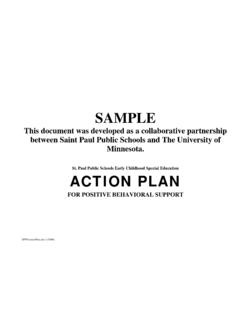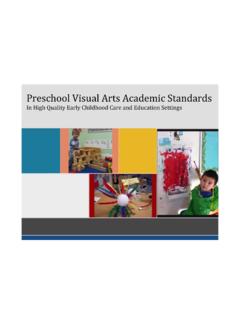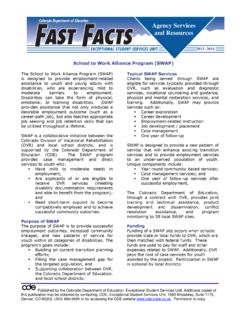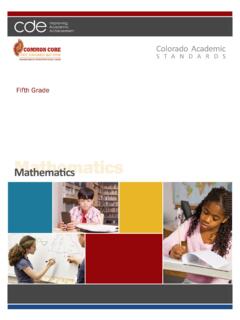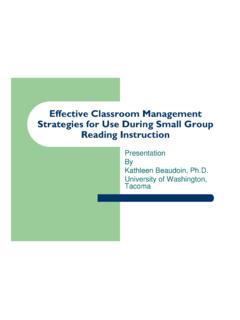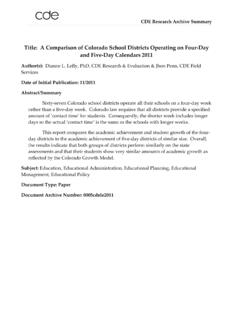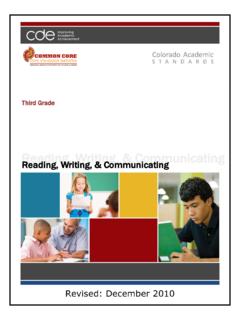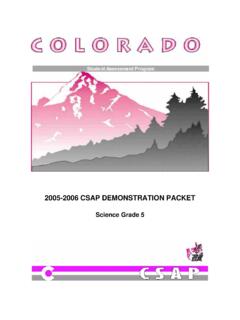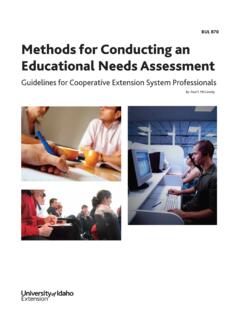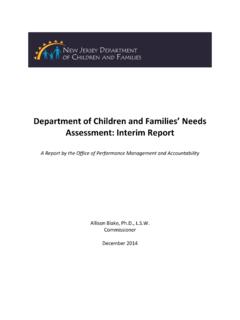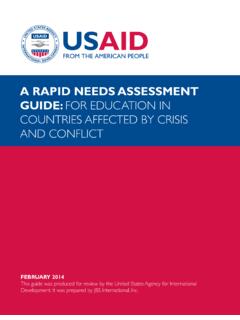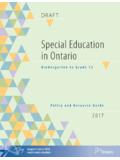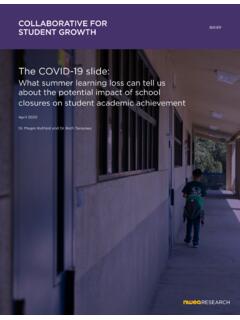Transcription of A Guide to Comprehensive Needs Assessment
1 A Guide for Comprehensive Needs Assessment Prepared for the Colorado Department of Education by RMC Research Corporation, a subcontractor to the Southwest Comprehensive Center at WestEd This work was developed by the Southwest Comprehensive Center at WestEd under a grant from the Department of Education. However, these contents do not necessarily represent the policy of the Department of Education and you should not assume endorsement by the Federal government. The Southwest Comprehensive Center at WestEd, in partnership with RMC Research Corporation, is part of the federal network of sixteen Regional Comprehensive Centers serving individual or clusters of states. April 4, 2008. Contents What Is a Needs Assessment ? .. 1. Why Conduct a Needs Assessment ?.. 2. Dimensions of a Comprehensive Needs Assessment .. 3. Components .. 3. 4. Information Gathering .. 4. Planning 4. Use of Results .. 5. Planning for Comprehensive Needs Assessment .
2 5. Data Collection and 9. Gathering Existing Data .. 9. Student 9. Student Achievement 9. Curriculum and Instruction .. 10. Professional Development .. 10. Technology .. 11. Family/Community Involvement Measures .. 11. Early Childhood Assessment 12. Gathering New Data .. 12. Data Collection Logistics .. 12. Collecting Valid and Reliable Data .. 12. Data 13. Prioritize Needs .. 13. Identify Root Causes .. 13. Summarize Findings .. 14. Making 14. Reporting Needs Assessment Results .. 14. Comprehensive Planning .. 15. Unified School Improvement Planning .. 15. District Improvement Planning .. 16. Taking Action .. 17. Implementing Strategies to Meet Needs .. 17. Example Needs Assessment : Low Achievement in Reading .. 18. Needs Assessment Activity: Needs Assessment for Use of Title II, Part A 20. References Appendices Checklist of Essential Needs Assessment Steps Federal Legislation Summaries Consolidated Application Needs Assessment Requirements What Is a Needs Assessment ?
3 The phrase Needs Assessment is used rather loosely in the educational vernacular. As currently implemented, a Needs Assessment can mean anything from asking individuals connected with education what they need to close the gap between current status and some desired state, such as all students reaching proficiency, to conducting a Comprehensive research project, complete with a specified set of procedures such as statistical analysis, case studies, and student focus groups. In both cases, there is an attempt to assess or measure a perceived or actual need by collecting data to document a challenge that exists. For federal programs, typically this means that local staff must collect data that help illuminate the path to improvement. Various funding programs within the No Child Left Behind (NCLB) Act have specific requirements for conducting a Needs Assessment . The requirements are presented in the Appendix. Generally, the requirements are as follows: Title I, Part A (basic programs for students from economically disadvantaged backgrounds).
4 Staff with schoolwide programs must conduct annual Comprehensive Needs assessments that include analyses of student achievement data relative to proficiency expectations and involve parents and community members, teachers, principals, administrators (including those from other Title I. programs), and if appropriate, pupil services personnel, technical assistance providers, school staff, and students, if for a secondary school. The overall purpose of the Comprehensive Needs Assessment is to identify gaps between the current status of the school and its vision of where it wants to be, relative to key indicators or focus areas (Nonregulatory Guidance, p. 14). The guidance suggests using a Needs Assessment process that includes establishing a schoolwide planning team, clarifying the vision of school reform to identify school strengths and weaknesses, creating the school profile, identifying data sources for the Needs Assessment , and analyzing the collected data.
5 The section on creating a school profile (Nonregulatory Guidance, pp. 10-13) contains a number of questions that might be used on a Comprehensive Needs Assessment . Schools with targeted assistance programs are also to conduct a Needs Assessment to determine those children with the greatest need to be served. In these schools, if health, nutrition, and other social services to address Needs (such as basic medical equipment eyeglasses and hearing aids, a program coordinator, or professional development about identifying and meeting these children's Needs ) are identified by a Comprehensive Needs Assessment , some funds can be used to fill these Needs through a collaborative partnership with local service providers. Title I, Part C (migrant education) programs must identify the special educational Needs of migratory children as part of their Comprehensive planning process. The state education agency (SEA) often takes the lead and plans a Needs Assessment in conjunction with local and state programs that receive federal funds.
6 1. Title II (high quality teachers (HQTs) and principals) programs are to conduct Needs assessments to determine the knowledge and skills needed by teachers and the instructional leadership skills required of principals to ensure that students meet standards. Teachers at individual schools must be involved in the Needs Assessment process. While no specific types of data are required, the law suggests that the Needs Assessment include: Student achievement data;. Information on national and state initiatives;. Anticipated professional development Needs of core subject area teachers;. Anticipated teacher supply and demand;. Student enrollment data;. Results of program evaluations; and Input from community and business. Funds are to be used to target those activities most likely to improve instruction and student achievement. Title III programs (English language learners [ELL] and immigrant students) must include a description of the need for their programs in their applications.
7 The Needs Assessment must include numbers of students who are designated as being limited English proficient (LEP) in the school district to be served and information on the students' characteristics including their native language, their proficiency in English and in their native language, achievement data in reading/language arts and mathematics, a comparison of achievement data for ELL and non-ELL. students, and a summary of the previous schooling experiences of the children. The Assessment also should reflect the professional development Needs of the instructional personnel who will provide services to the ELL students. Title V also specifies that Needs assessments for programs that receive character education funds, the Needs of gifted/talented students, and local Needs for innovative programs are to be determined. Why Conduct a Needs Assessment ? The requirements for program-level Needs assessments are connected to the purpose of the program.
8 For example, since Title I exists to help students to reach proficiency and close the achievement gap, the Needs Assessment requirements are there to discover the challenges related to goals. In this case, the research shows that attendance; parent involvement; school climate;. leadership; and students being on grade level on assessments of 2. reading, language arts, and mathematics are all related to students doing well on summative tests such as the Colorado Student Assessment Program (CSAP). Measuring these predictors of test scores shows where some of the Needs may lie. A Needs Assessment also: Provides direction for programs, projects, and activities;. Allows staff to determine priorities and allocate limited resources to activities that will have the greatest impact;. Creates cohesion through the alignment of goals, strategies, professional development, and desired outcomes;. Enables benchmarking and monitoring of implementation and impact; and Assists with continuous improvement activities by helping staff identify change, which instructional and other practices are working, and the strategies associated with the greatest success.
9 Dimensions of a Comprehensive Needs Assessment Components There is no single best way to conduct a Needs Assessment . Rather, the components in a Needs Assessment should be determined by local context. The state of Massachusetts (2008) has identified some common or suggested components or characteristics of a Needs Assessment : Considers a range of Needs or issues;. Includes information gathered from a variety of sources;. Employs the use of valid and reliable data to the maximum extent possible;. Meaningfully involves many individuals representing a range of knowledge, skills and expertise;. Results in the development of goals and action plans;. Used as the basis for resource allocation; and Includes regular follow up and evaluation of plans and strategies. 3. Focus Assessment of Needs should focus on those factors that have the potential to impact the achievement of students. At a minimum, Needs assessments should address: test score results in the aggregate and for subgroups, dropout rates, student mobility, attendance rates, and graduation rates.
10 Curriculum and instruction issues should also be examined, including alignment with Colorado Model Content Standards and Assessment frameworks. Professional development Needs should also be assessed including teacher qualifications, the nature of professional development, and planning time for teachers. Family and community involvement should be explored and should involve communication with parents about student achievement, their involvement in decisions, supports provided to families, and/or business partnerships. School and district organization provide contextual information that is important for framing Needs . Vision, mission, decision-making structures, central office support, and budgetary issues are some contextual factors to consider. Information Gathering Information in a Comprehensive Needs Assessment is gathered from a variety of sources. Quantitative data sources include CSAP scores, CSAP Alternate (CSAPA) scores, Colorado English Language Acquisition (CELA) scores, Colorado ACT results, adequate yearly progress (AYP) status and School Accountability Report (SAR) status and information.
